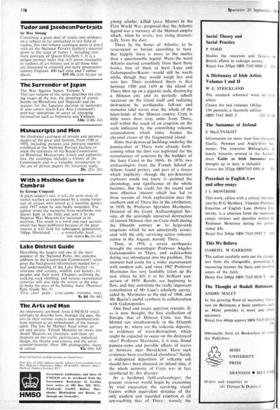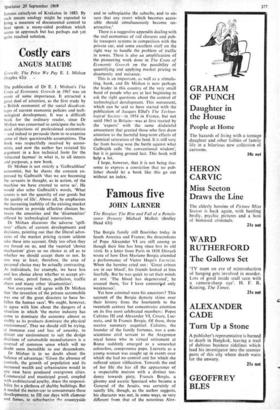Atlantis : fantasy and fact
MORTIMER WHEELER
Voyage to Atlantis J. W. Mayor Jr Souvenir Press 42s) The End of Atlantis: New Light on an Old Legend J. V. Luce (Thames and Hudson Os) Atlantis: The Truth behind the Legend A. 6. Galanopoulos and E. Bacon (Nelson 70s) It is calculated that upwards of two thousand works have been written about the lost island or continent of Plato's Atlantis. By coincidence the present year has produced three more, provoked largely by new or confirmed discovery, enhanced no doubt by the continuing saleability of a name which, like that of good King Arthur, retains its obstinate appeal to the lunatic fringe on both sides of the veritable Atlantic.
The lost island was the cradle of civil- isation, the home of sun-worship, the source of bronze and iron technology, the parent of the Phoenician language, the original seat of the Aryans, the Semites, and possibly the Turanian' races; it colonised Egypt, popu- lated the shores of the Gulf of Mexico, the Pacific coast of South America, the Baltic, the Black Sea, the Caspian: it was 'the true Antediluvian world; the Garden of Eden,
he Garden of the Hesperides, the Elysian ields, the Gardens of Alcinous, the lesomphalos, the Olympos, the Asgard of the traditions of the ancient nations'. So wrote a Congressman and 'assiduous re- searcher' of the United States in 1882. His book was long a bestseller and was thought uorthy of reissue as recently as 1949.
Nor is the ghost yet entirely laid. James W. Mayor announces that his new book was inspired by the dream of Atlantis . . . he greatest legend of the sea'. He is an I
-eanographic engineer of some achieve- cnt, but he is writing here as an enthusiastic
d highly press-conscious amateur. He )y ages to the island of Thera (ex-Santorini), has now received some acceptance as e factual nub of the Atlantis legend, and s 'excitement' was 'intense' as he approached that volcanic monstrosity on an American research vessel. He was received by a young man with 'an appropriately Byronic air of intensity and adventure' and, after only one day at Thera', the expedition 'had suggested a correlation between Thera and the metropolis of Atlantis'. At the end of this revealing enterprise, the author and his friends returned full of information, most of which was in fact already widely familiar, were met (with manifest gratification) by a group of reporters at Rhodes, and finally 'left Athens amid the furor of publicity, some of it regrettable but some quite welcome ... Once again the magic attraction of Atlantis was proving its spell'. The com- ment of an old-fashioned English reviewer can only be that it proves much else as well.
Beside this inflated travelogue, the other two books noticed are sober productions, though even here the Atlantis overtone tends to become a trifle fatiguing. They run parallel courses and are well illustrated, with a fair sprinkling of acceptable colour. Briefly their theme is this. Plato about 375 sc recounted a priestly tradition, com- municated about 594 ac to the Greek law- giver Solon on a visit to Egypt, that a great island. situated in the Atlantic outside the straits of Gibraltar had, some eight to nine thousand years previously, supported an advanced and ambitious bronze-age civilisation which sought to extend its empire eastwards to Italy, Greece and Egypt, but was stopped by the Athenians. After- wards, however, violent earthquakes and floods simultaneously overwhelmed both the Athenians and Atlantis.
Is there any vestige of truth in all this? The answer, from Aristotle to Jowett, has often, but perhaps not often enough, been No. Geologically it is agreed that no such island ever existed in the Atlantic. Geo- graphically there can have been no island of the alleged size of Atlantis (345 by 230 miles) in the Mediterranean. Technologi- cally the antiquity of the bronze age never on any computation approached eight to nine thousand years before Solon. Only by the most drastic and arbitrary amendments can the Atlantis story begin to be feasible. There are reputable scholars who have not refrained from taking this risk, and the revolutionary discovery of Minoan Crete in the first forty years of the present century lured conjecture. As long ago as 1909 a
young scholar, killed (pace Mayor) in the First World War, proposed that the Atlantis legend was a memory of the Minoan empire which, when he wrote, was rising dramati- cally from the dust.
There lie the bones of Atlantis, to be resurrected or buried according to taste. But happily there is more to the matter than a questionable legend. Were the word Atlantis excised completely from these three books, two of them at least—Luce and Galanopoulos-Bacon—would still be worth while, though they would weigh less and cost less. Their combined thesis is that between 1500 and 1450 "lc the island of Thera blew up on a gigantic scale, destroying a Minoan city and its partially rebuilt successor on the island itself and radiating destruction by earthquake, fall-out and immense tidal waves over the whole of the heart-lands of the Minoan empire. Crete is little more than sixty miles from Thera, well within the reach of an eruption on the scale indicated by the astonishing volcanic accumulation which today frames the abysmal crater of the fragmented island.
Hints that destroyed buildings underlay the pumice-dust of Thera were already forth- coming when the dust was exploited for the manufacture of concrete by the builders of the Suez Canal in the 1860s. In 1870, two archaeologists from the French School at Athens found pottery and part of a fresco which implicitly—though the pre-Knossian explorers could not know it—pointed the chronology and significance of the whole business. But the credit for the recent and now effective interest which has led to three seasons of fresh exploration near the southern end of Thera lies in the attribution, in 1939, by Professor Spyridon Marinatos, Director of the Greek Archaeological Ser- vice, of the seemingly universal destruction of known Minoan sites on Crete itself during the fifteenth century ec to large-scale eruptions which he not unnaturally associ- ated with the only surviving active volcanic centre in the Aegean, namely Thera.
Then, in 1956, a severe earthquake brought the seismologist Professor Angelos Galanopoulos to Thera, and radiocarbon dating was introduced into the problem. The moment had come for a wider reassessment with modern aids, and since 1967 Professor Marinatos has very laudably taken up the task where he left it in his brilliant con- jecture of 1939. Results are beginning to flow, and they constitute the really important contribution of Mr Luce's scholarly survey, aided by Marinatos to the end of 1968, and Mr Bacon's useful synthesis in collaboration with Galanopoulos.
One final and major question remains. If, as is now thought, the first civilisation of Europe, that of Minoan Crete, was thus blotted out simultaneously in the fifteenth century BC, where are the volcanic deposits, or evidences of wave-destruction, which might be expected to occur on the destroyed sites? Professor Marinatos, it is true, found pumice-stone and possible effects of waves at Amnisos, near Herakleion. Have such evidences been overlooked elsewhere? Surely a widespread deposition of volcanic ash should have been detected on inland sites, if the whole economy of Crete was in fact smothered by this disaster.
As a hardened field-archaeologist, the present reviewer would begin by examining by trial excavation the surviving visual factors within equivalent distance of the only modern and recorded eruption, at all approaching that of Thera • namely the famous cataclysm of Krakatoa in 1883. By such means analogy might be expected to bring a measure of documented control to bear upon a many-sided problem which seems to approach but has perhaps not yet quite reached solution.










































 Previous page
Previous page